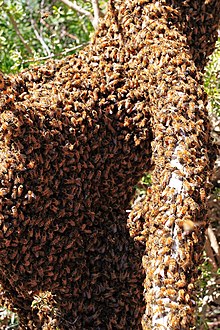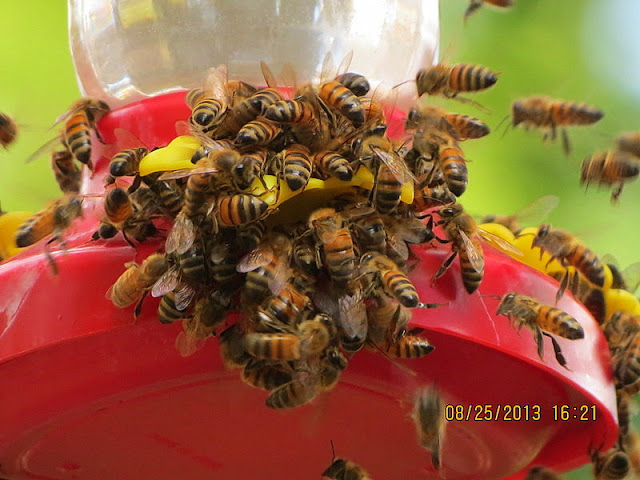Hi Everybody!!
OMG! You are not going to believe this! I sleepily walked to the kitchen window this morning in hopes of seeing happy little Elvis (the hummingbird) enjoying his nectar feeders on the portable hummingbird feeder rolling rack. No, it was more like instant eye opening to see one of the feeders full of bees, on the inside. I went running out to the deck for the rescue while trying to figure out what had happened. Number one: a swarm of honeybees of a thousand or so came in overnight to the Bird Sanctuary for the nectar feeders. (They follow the hummingbirds every year on the migration). Number 2: the feeders I filled the night before were empty. That means Rocky the Raccoon stole all the nectar overnight and while doing so, he knocked a yellow doodad off the feeder, creating the point of entry for the bees. So many bees were inside, they were beginning to die. I opened it up and poured the dying bees onto the ledge. Other bees came in and started cleaning the sugar coated bees. They all came back to life but 4. Elvis came up to get a bird's eye view on what was going on! Your photostudy tonight shows the feeder at different times of day with the swarming bees. Enjoy the Buzz!
Elvis checks out what's going on!
http://en.wikipedia.org/wiki/Swarming_(honey_bee)
Swarming (honey bee)
From Wikipedia, the free encyclopedia
A new honey bee colony is formed when the queen bee leaves the colony with a large group of worker bees, a process called swarming. In the prime swarm, about 60% of the worker bees leave the original hive location with the old queen. This swarm can contain thousands to tens of thousands of bees. Swarming is mainly a spring phenomenon, usually within a two- or three-week period depending on the locale, but occasional swarms can happen throughout the producing season. Swarming is the natural means of reproduction of honey beecolonies.
Secondary afterswarms may happen but are rare. Afterswarms are usually smaller and are accompanied by one or more virgin queens. Sometimes a beehive will swarm in succession until it is almost totally depleted of workers.[1][2]
Entomologists consider the colony as a superorganism. An individual bee without a colony cannot survive for long. The colony also needs a certain colony size to reproduce. In the process of swarming the original single colony reproduces to two and sometimes more colonies.[3]

Swarm behavior
A swarm of bees sometimes frightens people, though the bees are usually not aggressive at this stage of their life cycle. This is principally due to the swarming bees' lack of brood (developing bees) to defend and their interest in finding a new nesting location for their queen. This does not mean that bees from a swarm will not attack if they perceive a threat; however, most bees only attack in response to intrusions against their colony. Additionally, bees seldom swarm except when the position of the sun is direct and impressive. So-called "killer bees" swarm far more often than regular honeybees. Swarm clusters, hanging off of a tree branch, will move on and find a suitable nesting location in a day or two. Beekeepers are sometimes called to capture swarms that are cast by feral honey bees or from the hives of domestic beekeepers.[4][5]
Swarm preparation
The worker bees create queen cups throughout the year. When the hive gets ready to swarm the queen lays eggs into the queen cups. New queens are raised and the hive may swarm as soon as the queen cells are capped and before the new virgin queens emerge from their queen cells. A laying queen is too heavy to fly long distances. Therefore, the workers will stop feeding her before the anticipated swarm date and the queen will stop laying eggs. Swarming creates an interruption in the brood cycle of the original colony. During the swarm preparation, scout bees will simply find a nearby location for the swarm to cluster. This intermediate stop is not for permanent habitation and will normally leave within three days to a suitable location. It is from this temporary location that the cluster will determine the final nest site based on the level of excitement of the dances of the scout bees.
Nest site selection
When a honey bee swarm emerges from a hive they do not fly far at first. They may gather in a tree or on a branch only a few meters from the hive. There, they cluster about the queen and send 20 - 50 scout bees out to find a suitable new nest locations. The scout bees are the most experienced foragers in the cluster. An individual scout returning to the cluster promotes a location she found. She uses a dance similar to thewaggle dance to indicate direction and distance to others in the cluster. The more excited she is about her findings the more excitedly she dances. If she can convince other scouts to check out the location she found, they may take off, check out the proposed site and promote the site further upon their return. Several different sites may be promoted by different scouts at first. After several hours and sometimes days, slowly a favorite location emerges from this decision making process. In order for a decision to be made in a relatively short amount of time (the swarm can only survive for about 3 days with the honey they gorged themselves with before leaving the hive), a decision will often be made when somewhere around 80% of the scouts have agreed upon a single location. When that happens, the whole cluster takes off and flies to it. A swarm may fly a kilometer or more to the scouted location. This collective decision making process is remarkably successful in identifying the most suitable new nest site and keeping the swarm intact. A good nest site has to be large enough to accommodate the swarm (about 15 liters in volume), has to be well protected from the elements, receive a certain amount of warmth from the sun and be not infested with ants.[6][7][8][9][10]
Swarming creates a vulnerable time in the life of honey bees. Cast swarms are provisioned only with the nectar or honey they carry in their stomachs. A swarm will starve if it does not quickly find a home and more nectar stores. This happens most often with early swarms that are cast on a warm day that is followed by cold or rainy weather in spring. The remnant colony after having cast one or more swarms is usually well provisioned with food, but the new queen can be lost or eaten by predators during her mating flight, or poor weather can prevent her mating flight. In this case the hive has no further young brood to raise additional queens, and it will not survive. As soon as an afterswarm (the second and subsequent swarm after the old queen leaves with the prime swarm) is established at a new location, the bees raise a new queen, or sometimes a replacement virgin queen is already present in the afterswarm.
Africanized bees are notable for their propensity to swarm or abscond. Absconding is a process where the whole hive leaves rather than splits like in swarming. Being tropical bees, they tend to swarm or abscond any time food is scarce, thus making themselves vulnerable in colder locales. Mainly for lack of sufficient winter stores, the africanized bee colonies tend to perish in the winter in higher latitudes.
...this is brendsue signing off from Rainbow Creek. See You next time! After all this commotion, I thought it would be peaceful to close with the Kites. AND, other good news: It rained today-Hooray!
O+O
































































































No comments:
Post a Comment
Hi Everybody! Please say hello and follow so I know you are here! Due to the inconsideration of people trying to put commercials on my blog comment area, I have restricted use of anonymous posts. Sorry that some hurt all.
My public email is katescabin@gmail.com No spammers or trolls